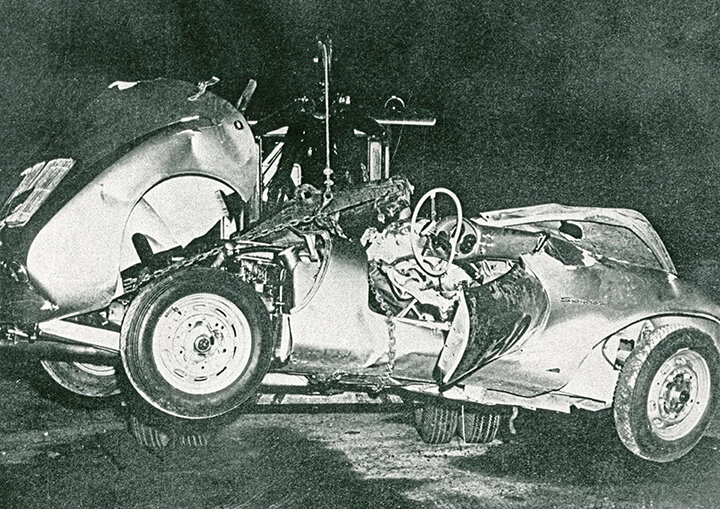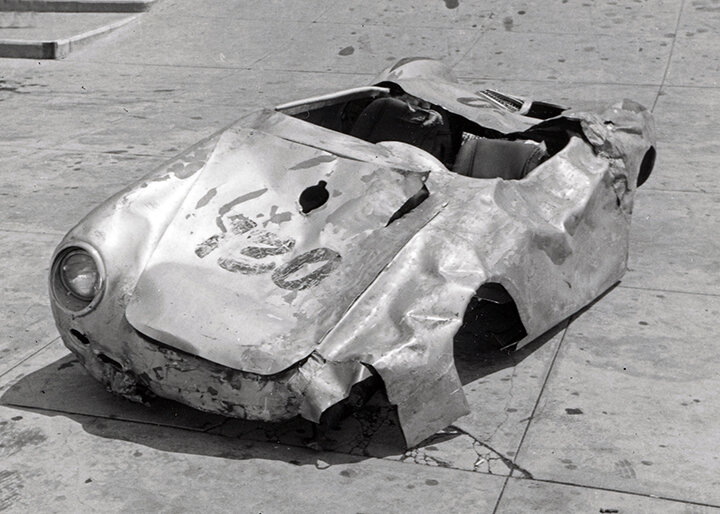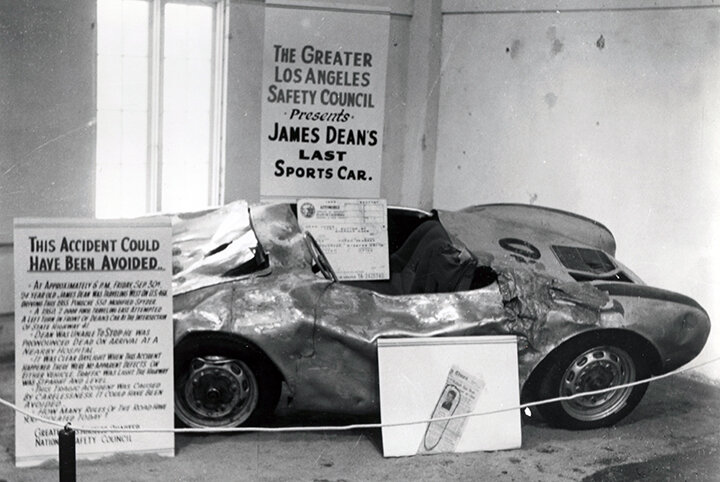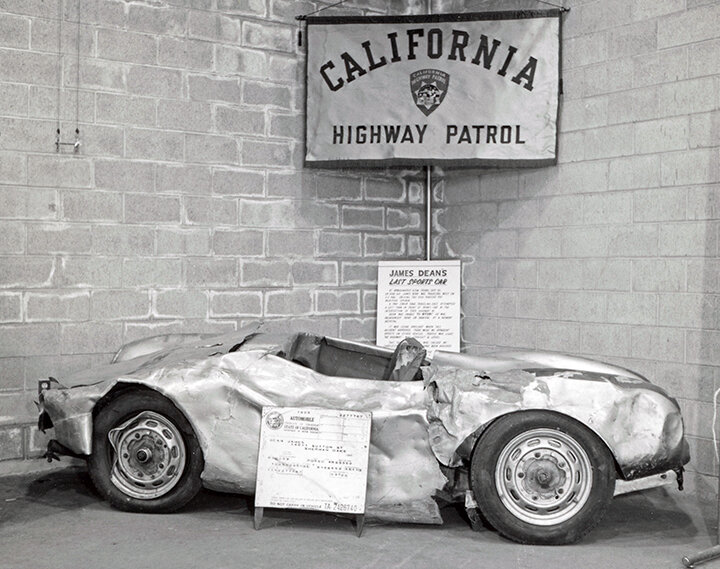Survivor ‘Container’ Porsche 550 Spyder—One of Only 90 Made
April 2021 • Presented by MicksPaint.comPorsche’s 550 Spyder may go down in history as one of the most iconic—and, ironically, infamous— sports racers of all time. Infamous, because a young James Dean died in his on September 30, 1955 the day after he wrapped filming Giant with Elizabeth Taylor and Rock Hudson. It was ironic because the 550 was known as the ‘Giant Killer’ because of it prowess on the track.
Porsche created the 550 in 1953 and its first race was in May at the Nurburgring. One month later, two cars were entered in the 24 Hours of Le Mans where they took first and second place in their 1500 class and 15th and 16th overall. The first car was driven by Richard von Frankenberg and Paul Frere and the second car by Helmut ‘Helm’ Glocker and Hans Hermann. The following yearJohnny Claes and Pierre Stasse came 12th while ‘Father of the Corvette’ Zora Arkus-Duntov and Gonzague Olivier came 14th—both cars were RS Spyders.
A 550 also won its class in that year’s Carrera PanAmericana causing the US importer Max Hoffman to petition the factory to import the car. Meanwhile, Porsche commissioned Reutlingen coachbuilder Wendler to build 69 cars for private customers, including 33 for the US. Hoffman renamed the 550/1500RS numeric nomenclature to the simpler ‘Spyder.’
In March 1955, James Dean traded his MG for a new ’55 Speedster #055 from John von Neumann’s Competition Motors at 1219 N. Vine Street, Hollywood. Not long after buying the Spyder, Dean traveled down to Dean Jeffries’ shop on Atlantic Boulevard, Lynwood where he had Jeffries letter #130 on the doors, hood and engine cover. He also lettered the words ‘Little Bastard’ above the rear license plate light.
On September 30, Dean was on his way to compete in a road race at Salinas when Donald Turnupseed left turned into the oncoming Porsche and punched out his lights. Dean was killed instantly but his mechanic Rolf Wütherich was thrown clear, though not unharmed.




King of the Kustomizers George Barris ended up with the remains of the body and cobbled together this somewhat tasteless ‘safety’ display.
After the accident, Dr. William Eschrich purchased the remains and swapped the engine into his Lotus IX. What was left of the body ended up with George Barris who cobbled it into a display for The Greater Los Angeles Safety Council and the California Highway Patrol—ironic since Dean had shot a road safety film just before his death.
Because of this celebrity notoriety, but more importantly because of its racing heritage, the 550 has gained an enviable reputation. And, because so few were built, prices have escalated dramatically. You can understand our shock, therefore, when our buddy Bobby Green of Old Crow Speed Shop announced he had found one in a container in Orange County, CA.
Bobby admits he didn’t actually find it, a lot of people knew it was there, including the family of deceased owner Les Gunnerson, but as Bobby says: “I wanted to be the one to pull it out of that container and get it sold for the family. A lot of shady characters had been sniffing around and the family were getting nervous.”

Gunnerson, an enthusiastic amateur race driver, purchased #550-0069 in 1963 and according to the copious archive he left with the car, purchased it from an ad in an auto trader. It had front-end damage and the engine was missing but it was $2K or trade for a Chevy or a Pontiac.
According to type550.com #550-0069 was completed on October 14, 1955, finished in white with engine # P90075. The car was ordered by Albert Hosking of Pasadena, CA who owned a number of 550s. It was painted red when Hosking owned it, so it is unsure if it was delivered red or painted later. The Spyder was maintained by car builder Art Sparks and mechanic Clyde Jones from Indianapolis, and was driven by Jean Pierre Kunstle and Johnny Mantz whose first race was at Nassau Speed Week in December 1955, where he finished third. Over the next few months Kunstle raced at Torrey Pines, Santa Barbara, Palm Springs and Pomona, finishing with podium results for most races.
Packed in a container for almost 40 years with four motorcycles hanging above.
In April 1957, the spyder was brokered by Kunstle to Ray Turnbull and shipped to Hawaii to race in the Hawaiian International Sports Car Week. Turnbull shared the driving with his sister Loretta Richert (nee Turnbull) who later bought the Spyder from her brother and raced it to victory throughout Hawaii until February 1961.
Bobby Green (right) looks over the Spyder in the now cleaned out container.
Gunnerson, who owned several Porsches including a 904 and a Speedster, eventually found and installed the correct engine. He received a letter from Dr. Porsche confirming that engine #75 was correct for #550-0069. However, he was using the cars to drive to and from work and one day somebody tried to steal one of them.
Worried that it would get stolen and after some restoration, Gunnerson locked the Porsche away in the early 80s and began collecting motorcycles. It was because of the bikes that Bobby got the call from friends, Grant Peterson and Mike Davis, who had been invited to look at this collection of bikes.
“What they found, besides a lot of bikes, was several Porsches,” said Bobby. “They didn’t know anything about them and called me hoping I could help. When I arrived, the container was jacked up with motorcycles and four were hanging over the car but I knew immediately knew this was the find of a lifetime.
“I know a lot about vintage sports and racing cars but not a lot about Porsche so I called my friend Blue Nelsen who, believe it or not was driven home from hospital by his folks after being born in a Speedster.
Blue immediately knew who to call and eventually a deal was brokered with Dutch collector Mark Wegh, owner of Porsche Centrum Gelderland who has the largest collection of rare Porsche, VW and Audi cars in private hands. He just added another.












